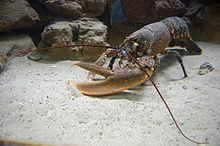Astacidea
| Astacidea Temporal range:
Middle Permian - present | |
|---|---|

| |
| Adriatic lobster | |

| |
| Crayfish: Austropotamobius pallipes | |
| Scientific classification | |
| Domain: | Eukaryota |
| Kingdom: | Animalia |
| Phylum: | Arthropoda |
| Class: | Malacostraca |
| Order: | Decapoda |
| Suborder: | Pleocyemata |
| (unranked): | Reptantia |
| Infraorder: | Astacidea Latreille, 1802 |
| Superfamilies | |
| |
Astacidea is an
, and their close relatives.Description
The Astacidea are distinguished from most other decapods by the presence of
Thaumastocheles, where the fifth pereiopod may have "a minute pincer".[2]
Distribution
Members of the infraorder Astacidea are found throughout the world – both in the oceans and in fresh water – except for mainland Africa and parts of Asia.[3]
Classification
Astacidea belongs to the group
sister clade to the infraorder Polychelida, a small group of crustaceans restricted to deep waters. The cladogram below shows Astacidea's placement within the larger order Decapoda, from analysis by Wolfe et al., 2019.[5]
| Decapoda |
| ||||||||||||||||||||||||
The infraorder Astacidea comprises five extant superfamilies, two of
Laurentaeglyphea neocaledonica) were formerly included here.[1]
The
| Astacidea |
| ||||||||||||||||||
Taxonomy
- Palaeopalaemonoidea †
- Enoplometopoidea
- Enoplometopidae
- Uncinidae †
- Nephropoidea
- Chilenophoberidae†
- Nephropidae
- Protastacidae†
- Stenochiridae †
- Astacoidea[7]
- Astacidae
- Cambaridae
- Cambaroididae
- Cricoidoscelosidae†
- Parastacoidea
References
- ^ ISBN 9780643099258.
- ISBN 92-5-103027-8.
- ^ J. K. Lowry (October 2, 1999). "Astacidea (Decapoda, Eucarida, Malacostraca)". Crustacea, the Higher Taxa. Australian Museum. Archived from the original on July 5, 2008. Retrieved October 24, 2012.
- ISBN 9789004207615.
- ^ PMID 31014217.
- ^ Raffles Bulletin of Zoology. Suppl. 21: 1–109. Archived from the original(PDF) on 2011-06-06. Retrieved 2010-02-22.
- ^ .
- PMID 24562813.
